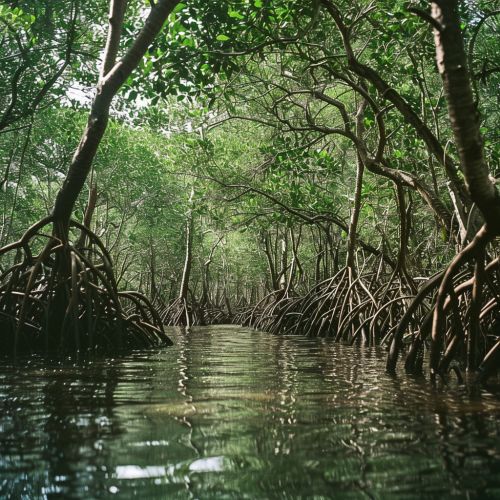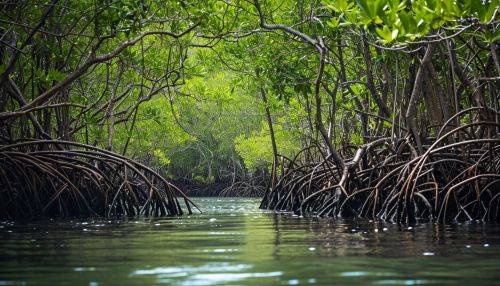Mangrove Forests
Introduction
Mangrove forests are unique ecosystems that are located in the intertidal zone of tropical and subtropical regions. These forests play a crucial role in the environment, providing a habitat for a wide variety of species and serving as a buffer between land and sea. They are characterized by the presence of mangrove trees, which are salt-tolerant trees with a complex root system that allows them to thrive in the harsh conditions of the intertidal zone.


Distribution and Habitat
Mangrove forests are found in 123 nations and territories in the tropics and subtropics, particularly in Southeast Asia, which houses over 40% of the world's mangrove forests. Other regions with significant mangrove coverage include the Americas, Africa, and the Pacific Islands. These forests occur along coastlines, in brackish water environments where freshwater from rivers and streams mixes with saltwater from the ocean. The unique environmental conditions of these areas, including high salinity, extreme tides, strong winds, high temperatures, and muddy, anaerobic soils, have led to the evolution of a diverse array of plant and animal species adapted to these challenging conditions.
Biology and Adaptations
Mangrove trees have developed a number of unique adaptations that enable them to survive in their challenging habitat. One such adaptation is the development of aerial roots, which emerge above the water or soil surface. These roots, known as pneumatophores, allow the trees to breathe in the oxygen-poor mud in which they grow. Another adaptation is the ability to excrete excess salt, a process known as salt secretion. Some mangrove species can also prevent the uptake of salt into their roots, a mechanism known as salt exclusion.
Mangrove trees also have a unique reproductive strategy known as vivipary. Unlike most plants, which release seeds that then need to germinate, mangrove trees release propagules - young plants that are already germinated and ready to grow as soon as they find suitable ground. This adaptation increases the chances of survival in the challenging mangrove environment.
Ecological Importance
Mangrove forests provide a number of important ecological services. They serve as a habitat for a wide variety of species, including many species of fish, birds, and mammals. Many of these species are endemic to mangrove forests, meaning they are found nowhere else in the world. Mangroves also serve as a nursery for many species of fish and shellfish, providing a safe place for these species to breed and grow before they move out to the open ocean.
In addition to providing habitat, mangrove forests also play a crucial role in carbon sequestration, capturing and storing large amounts of carbon dioxide from the atmosphere. This makes them a key player in mitigating climate change.
Mangrove forests also serve as a buffer between land and sea, protecting coastal areas from erosion, storm surges, and tsunamis. Their complex root systems stabilize the shoreline and prevent erosion by trapping sediments that flow down rivers and streams.
Threats and Conservation
Despite their ecological importance, mangrove forests are under threat from a variety of sources. The primary threat to mangroves is deforestation, often due to shrimp farming, agriculture, and urban development. Climate change also poses a significant threat, as rising sea levels can drown mangrove forests, while changes in temperature and rainfall patterns can alter their distribution and health.
Conservation of mangrove forests is crucial, and numerous efforts are underway to protect and restore these unique ecosystems. These include the establishment of protected areas, the implementation of sustainable forestry practices, and the restoration of degraded mangrove forests. Public education and awareness campaigns are also critical to ensuring the long-term survival of mangrove forests.
